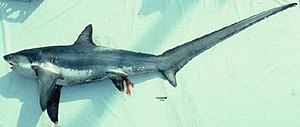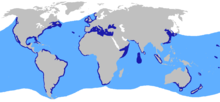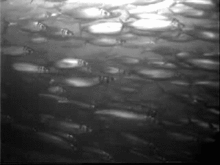Common thresher shark
| Common thresher shark | ||||||||||||
|---|---|---|---|---|---|---|---|---|---|---|---|---|

Common thresher shark ( Alopias vulpinus ) |
||||||||||||
| Systematics | ||||||||||||
|
||||||||||||
| Scientific name | ||||||||||||
| Alopias vulpinus | ||||||||||||
| ( Bonnaterre , 1788) |
The common thresher shark ( Alopias vulpinus ), also known as thresher (-hai), is a type of mackerel shark-like (Lamniformes) with a maximum body length of over six meters. This shark is particularly noticeable due to the very long upper part of the tail fin and can be found worldwide in the coastal areas of temperate to tropical seas. The shark uses the enlarged caudal fin mainly for hunting by striking its prey with it.
features
The common thresher shark reaches an average length of three to four meters and can reach a maximum length of over six meters. The currently largest thresher shark caught was 7.60 meters long, the largest weight so far was 340 kilograms.
The unusually large caudal fin with the strong tail root is particularly striking. The upper part of the caudal fin (upper lobe ) is almost as long as the rest of the body of the shark, while the lower part is not enlarged in comparison to other shark species. Like all mackerel shark species, this shark also has two dorsal fins, the first of which, like the sickle-shaped pectoral fins, is very large, while the second, like the anal fin, is very small and therefore only indistinctly recognizable. The first dorsal fin attaches behind the free rear end of the pectoral fins. The males have long, pointed clusters .
On the upper side, the species is dark, gray-black, bluish or greenish in color, the sides of the body are silvery or coppery and gray-black. The color on the ventral side is lighter to white. In the area of the base of the tail and below the pelvic fins, the dark flank color extends to the ventral side and dissolves here into an irregular pattern of spots and spots. The underside of the pectoral fins also has large dark spots, but has a large, V-shaped white area at the base. This distinguishes it from the Pacific thresher shark ( Alopias pelagicus ) together with the pointed pectoral fin ends and the slightly wider head .
The eyes, which have no nodding skins , are located on the side of the head and are very large, but do not extend to the top of the head as in the related bigeye thresher shark ( Alopias superciliosus ). It also has V-shaped furrows on both sides of the head (viewed from above), a longer snout and fewer teeth.
The snout is conical in shape and the labial folds on both sides of the relatively small mouth are only short. The teeth of the upper and lower jaw are pointed and curved. They only have one point and have finely sawn edges. The sharks have 19 to 26 teeth on both sides in the upper jaw and 21 to 24 teeth in the lower jaw. The shark has a very small suction hole and five gill slits , with the 4th and 5th gill slits above the base of the pectoral fin. The placoid scales , equipped with horizontally aligned cutting edges, stand close together and partially overlap one another; with a size of 0.2 × 0.21 mm, they are very small.
distribution
The common thresher shark lives almost worldwide near the coast and pelagically at depths of up to 350 meters in tropical, subtropical and temperate latitudes of the Atlantic , Indian and Pacific Oceans . In the West Atlantic, its distribution area extends from Newfoundland to the Caribbean around Cuba and from there further south to southern Brazil and Argentina ; in the East Atlantic it can be found from Norway and the British Isles across the entire European Atlantic coast including the Mediterranean Sea to Ghana and the Ivory Coast . The Indo-Pacific distribution area extends from South Africa over the entire East African coast including Madagascar to the Arabian Peninsula and the Gulf of Aden and from there over the coasts of Pakistan , India , Sri Lanka , China , Southeast Asia with Indonesia and the Philippines , Japan and Korea to Australia , New Zealand and the surrounding islands ( Oceania ). On the American Pacific coast it can be found from the coast from British Columbia to Baja California and from there via Central America to Chile .
In the Mediterranean, it is a common species that can be found in all areas and which also regularly gives birth to young animals , especially in the Golfe du Lion and off the Spanish coasts. The thresher sharks of the European coasts migrate north in summer and come to the North Sea and the Skagerrak , which is why they are rarely found in the Baltic Sea.
behavior
The thresher shark is an active and fast swimmer who, like other sharks, has a slightly higher body temperature than seawater (pseudo-warm blooded animals). He lives as a loner or in small, sometimes same-sex groups. He is also known for making meter-high jumps out of the water. Adult thresher sharks can be prey of the killer whale ( Orcinus orca ), as observations from New Zealand show.
nutrition
The shark feeds primarily on small to medium-sized bony fish, which make up about 97% of its diet. These are mainly small to medium-sized schooling fish such as menharden , herrings , mackerel , mackerel pike , butterfish , sardines and sand eels . More rarely they also hunt bonitos and other larger fish, cephalopods , crustaceans and, very rarely, sea birds. The sharks show seasonal migrations along the coasts, following their schools of food.
To hunt, the shark circles schools of fish and uses its very long tail fin to hunt by striking the schools of fish with its upper lobe, killing or stunning individual fish, which it then eats. The name “Thresher Shark” is derived from this hunting method: it thrashes its prey with its tail like a flail. On April 14, 1923, the oceanographer WE Allen was able to observe an approximately two meter long thresher shark chasing a fish (probably Atherinopsis californiensis ). The shark overtook the fish and swung its tail out of the water like a whip, seriously injuring the fish. The sharks can show this behavior both as individual animals and together with conspecifics, and the hunt for seabirds with tail strokes has already been observed. For example, the Irish ichthyologist Harry Blake-Knox claimed in the winter of 1865 that he saw a thresher shark in Dublin Bay as it hit a common loon ( Gavia always ) with its tail and then swallowed it. Blake-Knox's observation was subsequently questioned several times by experts, because in their opinion the tail is not muscular enough for such a blow.
Because of their hunting technique, thresher sharks are often victims of longline fishing: They get caught with their tail on hooks because they strike after caught fish as potential prey.
Reproduction and development
Thresher sharks, like other mackerel sharks, are viviparous (aplacentally viviparous). The mating season is usually in July and August (California), and after a gestation period of nine months, birth takes place from March to June (California), in summer (Sicily and Adriatic) or between January and May (northwestern Indian Ocean) The following year. The females carry one to six, on average four, young animals that feed on unfertilized eggs in the womb ( oophagia ).
At birth they are already 1.1 to 1.6 meters long and weigh 5 to 6 kg. They grow by about 50 centimeters as young animals and about 10 centimeters per year as adults. The animals reach sexual maturity regionally at different lengths; the males are sexually mature worldwide with a length between 2.6 and 3.4 meters at an age of three to seven years, the females around Australia with a length of 3.5 to 4 meters, in the Indian Ocean already 80 percent with 2 , 7 to 3.3 meters and before California with 2.6 to 3.2 meters. The maximum service life is 15 to 19 years.
Systematics
The common thresher was first described by Pierre Joseph Bonnaterre in 1788 on the basis of an individual from the Mediterranean as Squalus vulpinus . The first classification in today's genus Alopias was made as Alopias macrourus in 1810 by Constantine S. Rafinesque-Schmaltz (Rafinesque). Due to the International Rules for Zoological Nomenclature (ICZN), the valid name of the shark through the first description is Alopias vulpinus . A number of synonyms have appeared since the first description and have been discarded or synonymous with the type already described.
The common thresher shark , together with the big-eyed and the Pacific thresher, forms the genus Alopias , whereby it is compared to these two species together as sister species on the basis of molecular biological studies .
| Thresher sharks |
|
||||||||||||
|
|
No subspecies are described within the species, but the molecular genetic investigations by Eitner 1995 suggest a potential new and so far not yet described fourth thresher shark whose members are currently still assigned to the common thresher.
etymology
(Gr.) Ἀλώπηξ is the fox; there is indeed no " alopias ", but in Athenaios the ἀλωπέκιας as a species of shark; (Latin) vulpinus "fox-like" (from vulpes ).
Thresher sharks and humans
Despite their size, thresher sharks are generally considered to be harmless. Individual attacks on boats were known, however; The Shark Attack Files record four boat attacks by Alopias species, probably the common thresher shark . Divers are usually circled at a great distance, no attacks are known.
threat
The common thresher shark is popular in sport fishing as it offers the angler a "tough fight" with jumps out of the water. The main threat, however, is commercial fishing, for which it is an important food fish in many regions and at the same time a common species in bycatch in driftnet fishing. The meat is sold and consumed as high-quality fresh meat or dried and salted. The large fins are also used as ingredients for shark fin soup , the skin can be made into shark leather , and the liver oil is a valuable source of vitamins. The species is sometimes very heavily overfished off California and in other areas of the Pacific and Indian Oceans. The population off California has declined by more than 50% over the past three generations due to fishing pressure.
It was classified in the IUCN Red List in 2000, but only in the "data deficient" category, as the data situation in many regions of the world is very sketchy. In 2007/2008 the IUCN announced that the common thresher shark was classified in the "vulnerable" category together with the two other thresher shark species on the basis of an investigation by the IUCN SSC Shark Specialist Group (SSG) into pelagic shark and ray species becomes.
supporting documents
- ↑ a b c d e f g Vanessa Jordan: Thresher Shark. Florida Museum of Natural History. Accessed June 28, 2009.
- ↑ a b c characteristics (if not otherwise named) after Compagno 1984 and Compagno et al. 2005.
- ↑ a b c De Maddalena & Bänsch 2005.
- ↑ after Compagno 1984.
- ^ A b Michael R. George, Heike Zidowitz: Checklist of the European cartilaginous fish species with scientific and German names. In: Zeitschrift für Fischkunde. Volume 8, Issue 1/2 2006; Pp. 71-78.
- ↑ Visser, IN: First Observations of Feeding on Thresher ( Alopias vulpinus ) and Hammerhead ( Sphyrna zygaena ) Sharks by Killer Whales ( Orcinus orca ) Specializing on Elasmobranch Prey . In: Aquatic Mammals . 31, No. 1, January 2005, pp. 83-88. doi : 10.1578 / AM.31.1.2005.83 .
- ↑ a b Ecology of the Common Thresher ( Alopias vulpinus )
- ↑ a b c d R. A. Martin: Biology of the Common Thresher (Alopias vulpinus) . ReefQuest Center for Shark Research.
- ↑ a b Information (if not otherwise stated) from Compagno 1984 and Compagno et al. 2005.
- ↑ A detailed list of synonyms can be found in Compagno 1984.
- ^ A b Blaise J. Eitner: Systematics of the Genus Alopias (Lamniformes: Alopiidae) with Evidence for the Existence of an Unrecognized Species. In: Copeia. 1995 (3), pp. 562-571.
- ↑ a b c Alopias vulpinus in the endangered Red List species the IUCN 2006. Posted by: Goldman, KJ & members of the Shark Specialist Group, 2002. Retrieved on 16 the Jun 2006.
- ↑ More oceanic sharks added to the IUCN Red List. (PDF; 13 kB) Press release of February 2, 2207.
- ↑ You can swim but you can't hide - more oceanic sharks on the IUCN Red List. ( Memento of the original from May 15, 2012 in the Internet Archive ) Info: The archive link was inserted automatically and has not yet been checked. Please check the original and archive link according to the instructions and then remove this notice. Press release from May 22, 2008.
literature
- Leonard Compagno , Marc Dando, Sarah Fowler: Sharks of the World. Princeton Field Guides, Princeton University Press , Princeton / Oxford 2005, ISBN 0-691-12072-2 , pp. 180-181.
- Leonard Compagno: Sharks of the world. An annotated and illustrated catalog of shark species known to date. Volume 2: Bullhead, mackerel and carpet sharks (Heterodontiformes, Lamniformes and Orectolobiformes). FAO Species Catalog for Fishery Purposes. No. 1, Vol. 2. FAO Rome 2001 ( Alopias vulpinus . Complete PDF )
- Alessandro de Maddalena, Harald Bänsch: Sharks in the Mediterranean. Franckh-Kosmos Verlag, Stuttgart 2005, ISBN 3-440-10458-3 , pp. 136-138.
- Ralf M. Hennemann: Sharks and rays worldwide. Jahr-Verlag, Hamburg 2001, ISBN 3-86132-584-5 , p. 69.
Web links
- Common thresher on Fishbase.org (English)
- Common thresher shark in the hai.ch database
- Vanessa Jordan: Thresher Shark. Florida Museum of Natural History. (English)
- RA Martin: Biology of the Common Thresher (Alopias vulpinus). ReefQuest Center for Shark Research.





